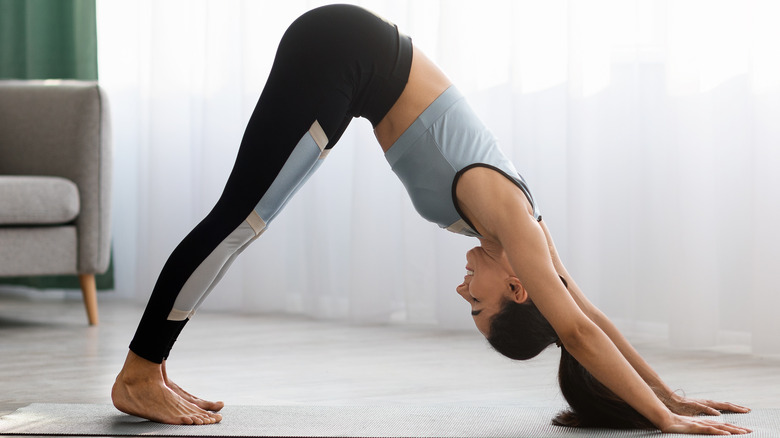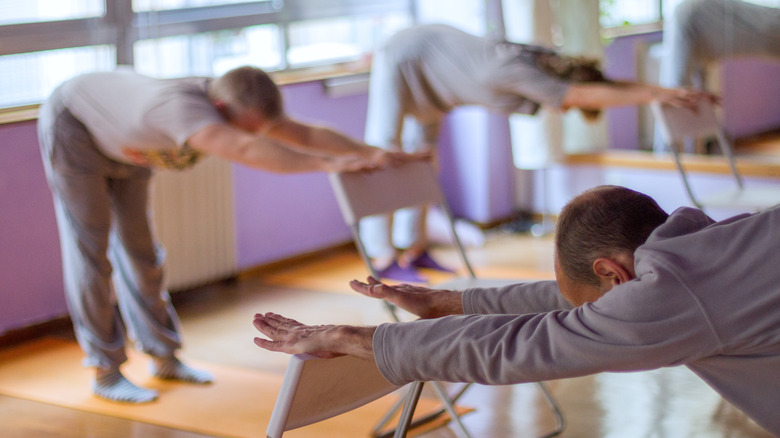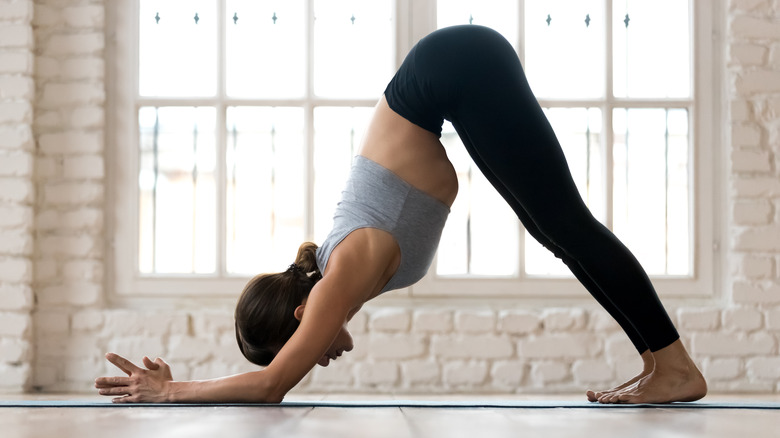Reasons You Might Want To Skip Downward Facing Dog Pose In Yoga
Downward-facing dog is so ubiquitous in yoga that people who've never stepped into a yoga class have heard of the pose. Yoga teachers will sometimes use downward-facing dog as a resting pose after a tough vinyasa sequence, or downward dog can be a pose on its own to stretch and strengthen the whole body. Downward dog requires a little bit of strength in your upper body because you're pushing your torso away from the mat using your arms, shoulders, and back. You'll also get a chance to stretch your spine and the back of your legs.
Downward dog might pose a challenge for some people, according to Tummee. The pose can tax the shoulders, ankles, and wrists, especially if the muscles that support them aren't conditioned. Because this pose is technically an inversion, meaning that the head is below the heart. People with high blood pressure or who are prone to migraines or vertigo should skip downward-facing dog. Downward facing dog also might not be the best pose for people with arthritis or carpal tunnel syndrome because it can put stress on the joints.
Modifications of downward-facing dog
If you have a wrist injury, you might not like placing weight on your wrists during downward dog. Having a chair or a wall nearby will help you get the stretch of a downward dog without the strain. Try placing your hands on the seat of a chair or draping them on the back of a chair. The wall will allow you to stretch the wrists a little more if your legs are perpendicular to the floor and your upper body is pressed into the wall. You can also place a rolled towel underneath your wrists to reduce the strain.
People who are less conditioned in the upper body can also practice downward dog against the wall. You can modify downward facing dog and begin to train the upper body by placing blocks under your hands. This will take off some of the weight from your arms and shoulders and send it toward your lower body. If you feel a strain in your calves or heels in downward dog, try placing blocks under your heels or shortening the distance between your feet and hands. If your shoulders are hurting, YogaJala recommends turning your hands slightly outward so your index fingers point toward the corners of your mat.
Alternative poses to downward-facing dog
Child's pose is often thought of as a true resting pose, especially when a yogi needs a break from challenging vinyasas. If your instructor calls for downward dog and your muscles or joints won't allow for it, drop to your knees and fold your torso into your lap. Yoga International recommends placing a block or bolster under your heels if your hips don't reach your heels. This pose is a great option for people with migraines or high blood pressure because it's not an inversion.
Two other alternatives to downward dog can give you similar strengthening benefits of the pose with a little less strain. Puppy pose is essentially downward dog with your knees on the mat. It's not quite child's pose where your hips sink over your heels — instead, puppy pose will have your hips elevated so they're on the same line as your knees. Dolphin pose is downward dog on your forearms rather than your hands, which places weight on your wrists. This pose will strengthen your shoulders, and it's typically a prep pose for forearm balance, as explained by Alo Moves.



